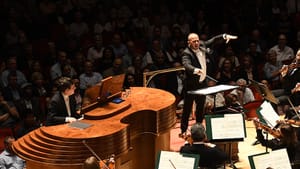Stay in the Loop
BSR publishes on a weekly schedule, with an email newsletter every Wednesday and Thursday morning. There’s no paywall, and subscribing is always free.
Mozart, Tchaikovsky, and Oquin, oh my
The Philadelphia Orchestra presents 'Yannick and Emanuel Ax' (second review)

The Philadelphia Orchestra is back, offering two repertoire stalwarts and an exciting new work at this past weekend’s season opener. I attended the last of three performances of this program, a pretty much full-house Sunday matinee.
Yannick Nézet-Séguin was joined by organist Paul Jacobs in the East Coast premiere of Wayne Oquin’s Resilience, for organ and orchestra. The composer, a 39-year-old Texas native, joined the orchestra and soloist for a bow at the conclusion of this complex, engaging work.
Two soloists, two successes
As its name would suggest, Resilience offers us plenty of Sturm und Drang in the first of three movements. It lingers in a lyrical, almost questioning mode throughout the second, and rebounds in the third movement with vivacity and determination. The second movement is particularly intriguing, emphasizing the woodwind origins of the pipe organ.
Of course, nothing could be further from the pipes of Pan than the Fred J. Cooper memorial organ, sprawling like a sci-fi behemoth over the Verizon Hall stage. Its resonance in full throttle is enough to liquefy the marrow in your bones. A familiar presence at these concerts, Jacobs was at ease and in full command of the instrument. He wowed the crowd with some fancy pedal work in the last movement that, yes, was musically integral to this largely tonal, accessible, robust composition.
Renowned pianist Emanuel Ax joined the orchestra for a performance of Mozart’s final piano concerto, the 27th in B-flat major. It’s a work of pure sunshine and delight, with a few shadows of foreboding (the composer died at age 35 the year of the work’s premiere in 1791).
Ax always looks happy, and why not? Mozart lives in his soul. What could be more delightful? This performance was neither spectacular nor showy, but, like Goldilocks’s porridge, was just right. The work can be a minefield for lesser pianists, rife as it is with tedious Alberti bass riffs that can be annoying if not subdued.
Yet there is a passage in the first movement that comes out of the blue around measures 226 to 230, about seven minutes into the piece. You would swear an angel entered the concert hall sprinkling stardust, making all the world’s pain disappear.
Buried in frenzy
Less satisfying for me was the final work on the program, Tchaikovsky’s Fourth Symphony in F minor, the first of the Russian composer’s three “big symphonies.” It is a great work, reflecting on not only purely musical conundrums but also on the anguished life of its author at this time, struggling with his own sexuality and the burden of overwhelming genius.
Some of this came out in the second and third movements, which featured exquisite woodwind playing (thank you, Richard Woodhams, principal oboe, and Daniel Matsukawa, principal bassoon). The orchestra overall survived the decision to play the first and fourth movements faster and louder than ever before, in keeping with the “classical music as pop entertainment” model we seem to be forced to embrace at this point in history. Here, I fear, I am in the small minority, as the large audience — a sight we crave to see and experience at all classical venues — roared its approval before the work concluded.
To me, speed and dynamics distorted the meaning. It is the conductor’s role to elucidate and clarify text, not bury it in frenzy and opacity. There is much going on in this music that is lost in the overtones and rattles generated by too much, too fast. But such is the world we live in. There should be many approaches to interpreting and performing the classical repertoire, and this is one of them.
To read Robert Zaller's review, click here.
What, When, Where
Yannick and Emanuel Ax. Resilience for Organ and Orchestra, by Wayne Oquin, Paul Jacobs, organ; Piano Concerto No. 27 in B-flat major (K. 595), by Mozart, Emanuel Ax, piano; Symphony No. 4 in F minor, Op. 36, by Tchaikovsky. The Philadelphia Orchestra. October 6 to 8, 2017, at the Kimmel Center's Verizon Hall, B300 S. Broad Street, Philadelphia. (215) 893-1999 or philorch.org.
Sign up for our newsletter
All of the week's new articles, all in one place. Sign up for the free weekly BSR newsletters, and don't miss a conversation.

 Linda Holt
Linda Holt